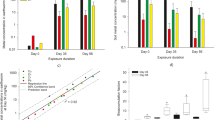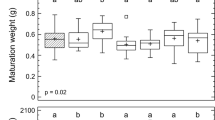Abstract
Earthworms have the potential to act as trophic links for pollutants that accumulate in urban soils. However, many pollutants may act as micronutrients at low concentrations and toxins at higher concentration. When pollutants are also micronutrients, bioaccumulations may initially increase trophic transfer as pollutant concentration increase, but at higher levels toxic effects may limit population size and the potential for trophic transfer. We found support for this model among earthworms exposed to a range of soil Zn levels. Worms showed increasing bioaccumulation of Zn with increasing Zn soil concentrations, but at higher Zn levels worm growth rates decreased.

Similar content being viewed by others
References
Burnham KP, Anderson DR (2002) Model selection and multimodel inference: A practical information-theoretic approach, 2nd edn. Springer Science + Business, New York
Councell TB, Duckenfield KU, Landa ER, Callender E (2004) Tire-wear particles as a source of zinc to the environment. Environ Sci Technol 38:4206–4214
Davis AP, Shokouhian M, Ni S (2001) Loading estimates of lead, copper, cadmium, and zinc in urban runoff from specific sources. Chemosphere 44:997–1009
Demuynck S, Grumiaux F, Mottier V, Schikorski D, Lemière S, Leprêtre A (2007) Cd/Zn exposure interactions on metallothionein response in Eisenia fetida (Annelida, Oligochaeta). Comp Biochem Physiol C Toxicol Pharmacol 145:658–668
Gellein K, Flaten TP, Erikson KM, Aschner M, Syversen T (2008) Leaching of trace elements from biological tissue by formalin fixation. Biol Trace Elem Res 121:221–225
Kamitani T, Kaneko N (2007) Species-specific heavy metal accumulation patterns of earthworms on a floodplain in Japan. Ecotoxicol Environ Saf 66:82–91
Lev SM, Landa ER, Szlavecz K, Casey RE, Snodgrass JW (2008) Application of synchrotron methods to assess the uptake of roadway-derived Zn by earthworms in an urban soil. Mineral Mag 72:191–195
Lokke H, Janssen CR, Lanno RP, Rombke J, Rundgren S, Van Straalen NM (2002) Soil toxicity tests—invertebrates. In: Fairbrother A, Glazebrook PW, Van Straalen NM, Tarazona JV (eds) Test methods to determine hazards of sparingly soluble metal compounds in soils. SETAC Press, Pensacola
Lukkari T, Taavitsainen M, Vaisanen A, Haimi J (2004) Effects of heavy metals on earthworms along contamination gradients in organic rich soils. Ecotoxicol Environ Saf 59:340–348
Nahmani J, Hodson ME, Black S (2007) A review of studies performed to assess metal uptake by earthworms. Environ Pollut 145:402–424
Nahmani J, Hodson ME, Devin S, Vijver MG (2009) Uptake kinetics of metals by the earthworm Eisenia fetida exposed to field-contaminated soils. Environ Pollut 10:2622–2628
Neuhauser EF, Cukic ZV, Malecki MR, Loehr RC, Durkin PR (1995) Bioconcentration and biokinetics of metals in the earthworm. Environ Pollut 89:293–301
OECD (2000) Guidelines for the Testing of Chemicals No. 222. Earthworm Reproduction Test, Geneva, Switzerland
Peijnenburg WJGM, Baerselman R, de Groot AC, Jager T, Posthuma L, Van Veen RPM (1999) Relating environmental availability to bioavailability: soil-type-dependent metal accumulation in the Oligochaete Eisenia andrei. Ecotoxicol Environ Saf 44:294–310
Spurgeon DJ, Hopkin SP (1999) Comparison of metal accumulation and excretion kinetics in earthworms (Eisenia fetida) exposed to contaminated field and laboratory soils. Appl Soil Eco 11:227–243
Sturzenbaum SR, Winters C, Galay M, Morgan AJ, Kille P (2001) Metal ion trafficking in earthworms. Identification of a cadmium-specific metallothionein. J Biol Chem 276:34013–34018
Vijver MG, Van Gestel CAM, Van Straalen NM, Lanno RP, Peijnenburg WJGM (2006) Biological significance of metals partitioned to subcellular fractions within earthworms (Aporrectodea caliginosa). Environ Toxicol Chem 25:807–814
Acknowledgments
We thank Towson University and NSF for funding to support instrumentation and personnel for this project (DMR-0116619; CHE-0420353, CHE-0754947). We thank Mark Monk for assistance with laboratory analysis.
Author information
Authors and Affiliations
Corresponding author
Rights and permissions
About this article
Cite this article
Lev, S.M., Matthies, N., Snodgrass, J.W. et al. Effects of Zinc Exposure on Earthworms, Lumbricus terrestris, in an Artificial Soil. Bull Environ Contam Toxicol 84, 687–691 (2010). https://doi.org/10.1007/s00128-010-0002-4
Received:
Accepted:
Published:
Issue Date:
DOI: https://doi.org/10.1007/s00128-010-0002-4




